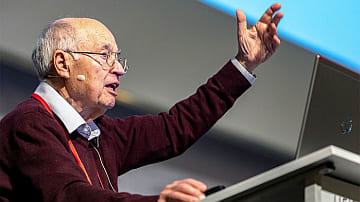2日前に「ついにリーマン予想が証明された!?」というセンセーショナルな記事を投稿したが、その後、どうも雲行きが怪しくなってきた。専門家の多くがアティヤ博士の今回の発表に対して、懐疑的、否定的な発言をするようになり、がっかりしたムードが漂っている。
9月24日にアティヤ博士のプレゼンが行われた。その一部はこのリンクから、全体はこのリンクからYouTube動画として見ることができる。
その後「Science」というウェブサイトでは、次のような記事が投稿されている。
Skepticism surrounds renowned mathematician’s attempted proof of 160-year-old hypothesis
https://www.sciencemag.org/news/2018/09/skepticism-surrounds-renowned-mathematician-s-attempted-proof-160-year-old-hypothesis?utm_source=newsfromscience&utm_medium=twitter&utm_campaign=160proofmath-21624
英語を読めない読者のために、つたない翻訳ではあるが日本語に訳してみた。不正確な箇所、誤訳などを見つけた方は、遠慮なくコメントしていただきたい。今後はどのような形で収束するのか、あるいは自然消滅するのかわからないが、引き続き見守っていくことにしたい。
日本語訳:

9月24日のハイデルベルグ受賞者フォーラムでリーマン予想の証明を発表する数学者のマイケル・アティヤ
高名な数学者による160年前の予想の証明に対し懐疑論が広がる
Frankie Schembri Sep. 24, 2018 , 5:15 PM
今日、有名な数学者がリーマン予想を証明したと発表した。これはおよそ160年間解決されなかった素数の分布に関する問題である。9月24日にドイツのハイデルベルグ受賞者フォーラムで行われた45分のプレゼンで、エジンバラ大学名誉教授(数学)のマイケル・アティヤは、およそ関連性がないと思われる物理学の手法を用いて、彼の表現に従えば、「簡潔な証明」として紹介したのだという。しかし、専門家の多くはその妥当性に疑いを持った。特にアティヤは89歳であり、ここ数年いくつかの間違いをおかしていたからだ。
「プレゼンで彼が示したものは、私たちが知っているリーマン予想とはとても似つかわしくないものだ。」 とトロンハイムのノルウェー科学技術大学で以前リーマン予想を学んだ経済学者のJorgen Veisdalは語った。「その証明はとても曖昧で不特定なもの」で、最終的な判定をするためには書かれた証明を検証する必要があると補足した。
リーマン予想は、これまで解決されていない最大かつ最後の数学の問題で、1859年にドイツの数学者ベルンハルト・リーマンによって初めて提唱された。これは2、3、5、7、11のように1かその数自身でしか割り切れない素数についての仮説である。素数は大きくなるにつれて数直線上では「まばら」になり、素数どうしの間隔は広くなっていく。リーマンは素数の分布を理解する鍵が、他の数の集合の中にあるということを発見した。それは実数と虚数の入力をもつリーマンゼータ関数のゼロ点の集合である。そして彼はゼータ関数のゼロ点に基づいて、特定の数までにいくつの素数があるか計算する公式や、素数どうしの間隔がどれくらいかを計算する公式を発見した。
しかし、リーマンの公式は、ゼータ関数のこれらのゼロ点の実数部分がすべて1/2に等しいと仮定した場合にのみ成り立つ。彼は最初のいくつかの素数についてこの性質を証明し、これまで100年間、たくさんの大きい素数でもこれが正しいことが計算で示されてきたのだが、無限に同じことがあてはまることは正式かつ明白な形で証明されてこなかった。その証明は、クレイ数学研究所が2000年に設立した7つのミレニアム問題の1つとして解決して得られる100万ドルの賞金を獲得するためだけでなく 暗号化に重要な役割を果たす素数を予測するアプリケーションのためにも必要なのだ。
アティヤは巨人であり、幾何学、トポロジー、そして理論物理学に対してこれまで大きな貢献をしてきた。数学では最高の賞であるフィールズ賞を1966年に、アーベル賞を2004年に受賞している。しかし長年に渡る豊富な経歴にもかかわらず、リーマンの主張の証明は失敗続きだった。
2017年、アティヤは、群論という抽象的な分野で1963年に初めて証明されたFeit-Thompsonの定理(奇数位数の有限群は可解であるという定理)を大幅に単純化して12ページの証明にしたとロンドンのタイムズ紙に語ったことがある。彼はその証明をその分野の専門家15人に送ったが、彼らは疑念を示すか無言のままで、その証明はついに雑誌に掲載されることはなかった。その前年には、ArXivというプレプリントのリポジトリ・サイトにアティヤは微分幾何学の有名な問題を解いたとして投稿したのだが、同僚たちは彼のアプローチが不正確であるとすぐ指摘し、その証明が正式に公表されることはなかった。
Science誌(この記事が掲載されているサイト名)は、アティヤの同僚の何人かに連絡した。すると全員が口をそろえて、アティヤが引退から返り咲きたいために不確かな連想に基づく証明をすることを心配していると語っていた。そして公に批判し、良き指導者または同僚である彼との関係を壊すようなことをしたいとは誰も望んでいなかった。リバーサイドにあるカリフォルニア大学の数理物理学者のJohn Baezは、アティヤの発表に対して批判的なコメントをしたいと思っている数少ない人物だ。「(アティヤの)証明は論証や実証とはまったく関係なく、印象的な主張の単なる積み重ねに過ぎなかった。」と彼は言う。
(プレゼンの)順番がきたときアティヤは動じなかった。「聴衆は物怖じしない若者と物知りな高齢者たちだ。私はライオンの群れに身を投げていたようなもので、無傷であることを願いたい。」とアティヤはプレゼンの前にメールで書いていた。アティヤによれば、証明と論文のコピーは、プレゼンの同意を得るために事前にオンラインで回覧されていたという。批判を受けながらもインタビューの中で、彼は自分の仕事がリーマン予想を証明するためだけでなく、まだ証明されていない他の数学の問題を証明するための具体的な基礎になるものだと断言した。そしてアティヤは「人々が不平や不満を言うのは、老人が全く新しい方法を見つけることが許せないのかもしれない。」とも言った。プレゼンで彼の証明のために使われたスライドはわずかで、ほとんどの時間はジョン・フォン・ノイマンやフリードリッヒ・ヒルツブルクなどが20世紀の数学にいかに貢献したか、そしてアティヤの証明が彼ら(の理論)に基づいていることを話した。
アティヤによる証明の要点は、電荷をもつ素粒子の間の電磁相互作用の強さと性質をあらわす微細構造定数と呼ばれる物理量に基づいているということだ。この定数と比較的曖昧な関係をもつトッド関数を使うことで、アティヤはリーマン予想が背理法で証明できると主張したのだ。
証明は5ページに書き上げられ、理論の多くの部分は彼自身による証明で実証され、論文は王立協会議事録Aにすでに送られたそうだ。その論文はまだ公表されていない。
ブログ執筆のはげみになりますので、1つずつ応援クリックをお願いします。







英語原文:
Skepticism surrounds renowned mathematician’s attempted proof of 160-year-old hypothesis
Frankie Schembri Sep. 24, 2018 , 5:15 PM
A famous mathematician today claimed he has solved the Riemann hypothesis, a problem relating to the distribution of prime numbers that has stood unsolved for nearly 160 years. In a 45-minute talk on 24 September at the Heidelberg Laureate Forum in Germany, Michael Atiyah, a mathematician emeritus at The University of Edinburgh, presented what he describes as a “simple proof” that relies on a tool from a seemingly unrelated problem in physics. But many experts doubt its validity, especially because Atiyah, 89, has been making mistakes in recent years.
“What he showed in the presentation is very unlikely to be anything like a proof of the Riemann hypothesis as we know it,” says Jorgen Veisdal, an economist at the Norwegian University of Science and Technology in Trondheim who has previously studied the Riemann hypothesis. “It is simply too vague and unspecific.” Veisdal added that he would need to examine the written proof more closely to make a definitive judgement.
The Riemann hypothesis, one of the last great unsolved problems in math, was first proposed in 1859 by German mathematician Bernhard Riemann. It is a supposition about prime numbers, such as two, three, five, seven, and 11, which can only be divided by one or themselves. They become less frequent, separated by ever-more-distant gaps on the number line. Riemann found that the key to understanding their distribution lay within another set of numbers, the zeroes of a function called the Riemann zeta function that has both real and imaginary inputs. And he invented a formula for calculating how many primes there are, up to a cutoff, and at what intervals these primes occur, based on the zeroes of the zeta function.
However, Riemann’s formula only holds if one assumes that the real parts of these zeta function zeroes are all equal to one-half. Reimann proved this property for the first few primes, and over the past century it has been computationally shown to work for many large numbers of primes, but it remains to be formally and indisputably proved out to infinity. A proof would not only win the $1 million reward that comes for solving one of the seven Millennium Prize Problems established by the Clay Mathematics Institute in 2000, but it could also have applications in predicting prime numbers, important in cryptography.
A giant in his field, Atiyah has made major contributions to geometry, topology, and theoretical physics. He has received both of math’s top awards, the Fields Medal in 1966 and the Abel Prize in 2004. But despite a long and prolific career, the Riemann claim follows on the heels of more recent, failed proofs.
In 2017, Atiyah told The Times of London that he had converted the 255-page Feit-Thompson theorem, an abstract theory dealing with groups of numbers first proved in 1963, into a vastly simplified 12-page proof. He sent his proof to 15 experts in the field and was met with skepticism or silence, and the proof was never printed in a journal. A year earlier, Atiyah claimed to have solved a famous problem in differential geometry in a paper he posted on the preprint repository ArXiv, but peers soon pointed out inaccuracies in his approach and the proof was never formally published.
Science contacted several of Atiyah’s colleagues. They all expressed concern about his desire to come out of retirement to present proofs based on shaky associations and said it was unlikely that his proof of the Riemann hypothesis would be successful. But none wanted to publicly criticize their mentor or colleague for fear of jeopardizing the relationship. John Baez, a mathematical physicist at the University of California, Riverside, was one of the few willing to put his name to critical remarks about Atiyah’s claim. “The proof just stacks one impressive claim on top of another without any connecting argument or real substantiation,” he says.
For his part, Atiyah seems unfazed. “The audience there has fearlessly bright youngsters and well-informed golden oldies,” Atiyah wrote in an email before his presentation. “I am throwing myself to the lions. I hope to emerge unscathed.” According to Atiyah, word of his proof and copies of his papers circulated online, prompting him to agree to the presentation. He says in an interview that despite criticism, his work lays down a concrete basis for proving not only the Riemann hypothesis, but other unproven problems in mathematics. “People will complain and grumble,” Atiyah says, “but that’s because they’re resistant to the idea that an old man might have come up with an entirely new method.” In his presentation, Atiyah devoted only a handful of slides to his proof, spending the majority of his time discussing the contributions of two 20th century mathematicians, John von Neumann and Friedrich Hirzebruch, on which he said his proof was based.
The crux of Atiyah’s proof depends on a quantity in physics called the fine structure constant, which describes the strength and nature of electromagnetic interaction between charged particles. By describing this constant using a relatively obscure relationship known as the Todd function, Atiyah claimed to be able to prove the Riemann hypothesis by contradiction.
In the five-page write-up of the proof, Atiyah attributes much of the theoretical work that underpins the proof to a paper of his own that has been submitted to the Proceedings of the Royal Society A. That paper has yet to be published.